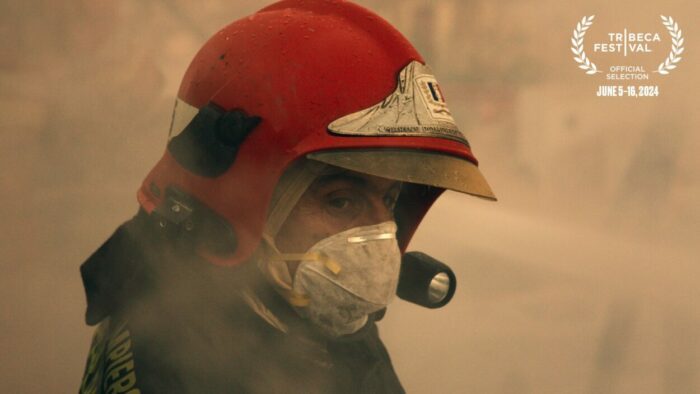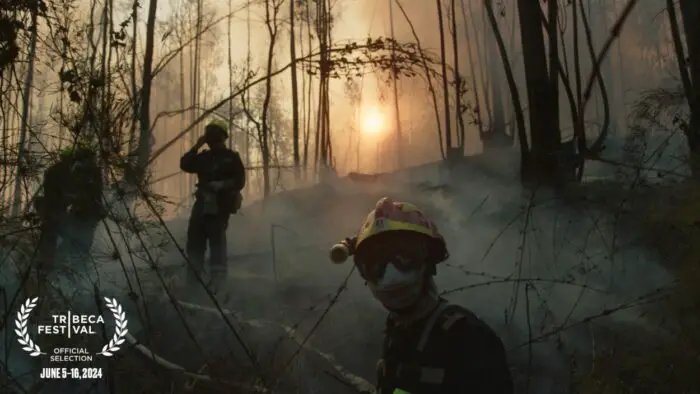For all the explosiveness and intensity a century of Hollywood effects has lent to depicting fire on film—think back to Rebecca or Gone with the Wind, or later to Carrie and then Backdraft, or more recently The Dark Knight or Inglorious Basterds—those artificially-induced yet still very real flames have nothing on those in the documentary feature Pirópolis, making its world debut at the 2024 Tribeca Film Festival. The film, the fourth from director Nicolás Molina (Gaucho Americano), follows a dedicated Chilean fire brigade as they fight a series of climate change-fueled wildfires that imperil their countryside and themselves with a life-threatening ferocity.
Pirópolis is told through the lens of cinema vérité, employing no on-screen graphics, voice-over or other narration, and no direct-address interviews. Rather, the camera follows the action of the firefighters like a rookie recruit in Molina’s hometown of Valparaiso, the Chilean port city, where an all-volunteer fire brigade with French ties nicknamed the “Pompe France” is tasked with staunching the spread of the the fires that surround the countryside.

The brigade is all ages—from seasoned veterans to new recruits—and for the first time, gender-inclusive. It’s one of many social changes Pompe France is undergoing amidst a broader social upheaval outside the fire station, where Chile more generally is rocked by national protests and a referendum to rewrite the national constitution. That their brigade is tied to France, with their captain practically obsessed with French culture and welcoming a guest expert from the country to test new firefighting techniques, lends another level of cultural complexity: the French influence is one of military hierarchy, codes of respect, and longstanding tradition, even if these Western values do not always translate to a modern South American country in the throes of rapid change and ecological devastation.
Pompe France, then, is deployed to fight on two fronts: the protests in the streets of Valparaiso and wildfires ravaging its countryside. This structure—a little like the Hollywood war film with its juxtaposition of moments of stasis and action, rest and combat—allows Molina to develop Pirópolis’s narrative using two very distinct locales. There is the fire station, where new recruits are trained, new techniques discussed, and the new presence of female firefighters debated; then there is the action in the field, where protesters are surveilled and fires are fought.

Those fire scenes are simply unequaled. It’s almost impossible to imagine exactly how Molina and crew could dare to manage to follow Pompe France into the fires themselves. Sparks fly, trees crackle, smoke billows all around, creating a nearly apocalyptic hellscape as the firefighters, communicating through masks and walk-talkies, mount what looks like an impossible battle. Visually and aurally, as Molina and crew chart both the devastation of the fires and the increasingly dire situation of those who fight them, what one sees onscreen in much of Pirópolis is simply audacious, a depiction of fires whose spread seems unstoppable and whose blazes sear with intensity.
The fires threaten not just the countryside but the city of Valparaiso itself, situated in a valley surrounded by hills and thus particularly vulnerable to fires. This past summer 131 lives were lost, as were over 12,500 homes. And while Valparaiso makes for a perfect case study with which to illustrate the challenges faced by firefighters in a context of social and cultural change, it’s not necessarily unique.

Pirópolis’s power is in its ability to remind viewers that in recent summers, blazes have torched the countrysides of Canada—its smoke dust reaching Europe—and Greece among others, evidence of climate change impacting the planet in ways both immediate and more deliberate. Those who fight them are brave indeed, all volunteers who receive no remuneration and give their time while balancing their commitments to day jobs, family, and personal life, even at great risk. And though their institutions must embrace change to survive, they are the last line of defense against flames that threaten to consume their country’s homes and people.
A mesmerizing slow burn of verité-style documentary, Pirópolis adroitly places those firefighters’ volunteerism in a complex social context of considerable change, while also making the case that without their work, the countryside—and likely adjacent to it, thousands of homes and hundreds of citizens—would perish, like earlier this year, in flames. It’s a heady responsibility, and Molina and his crew’s up-close look at their work in Pirópolis is both astonishing and instructive.



